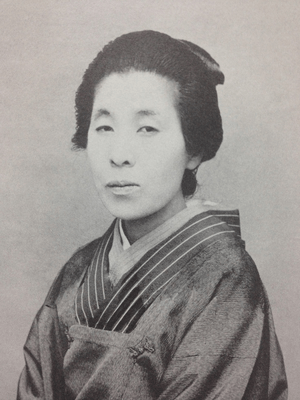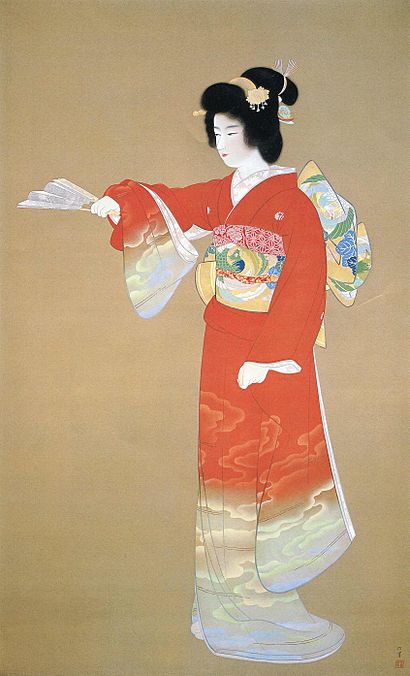Uemura Shōen facts for kids
Quick facts for kids
Uemura Shōen
|
|
|---|---|

Uemura Shōen
|
|
| Born |
Uemura Tsune
April 23, 1875 |
| Died | August 27, 1949 (aged 74) |
| Nationality | Japanese |
| Known for | Painter |
| Movement | Nihonga |
| Awards | Order of Culture |
Uemura Shōen (上村 松園, April 23, 1875 – August 27, 1949) was a famous Japanese painter. She lived during the Meiji, Taishō, and early Shōwa period. Her real name was Uemura Tsune, but she used "Shōen" as her artist name.
Shōen was best known for her bijin-ga paintings. These are artworks showing beautiful women. She painted in the nihonga style, which is a traditional Japanese painting style. She also created many works about history and traditional subjects. Shōen was seen as a big innovator in bijin-ga art. She often showed traditional ideas of beauty in her paintings.
During the Taishō era, bijin-ga art faced some criticism. People felt it did not show how women's lives were changing. In the earlier Edo period, women were often seen as lower class. Bijin-ga paintings sometimes showed this idea. But in the Taishō era, women were getting more jobs in Japan. Art became popular for more people, not just the rich. This helped Shōen become successful.
Shōen received many awards in her life. She was the first woman to get the Order of Culture award. This is a very important award in Japan. She was also hired as the Imperial Household Artist. This meant she was an official artist for the Emperor's family. Only one other woman had held this job before her. Shōen passed away from cancer in 1949. This was just one year after she received the Order of Culture Award.
Contents
Her Early Life and Artistic Journey
Shōen was born in Shimogyō-ku, Kyoto. She was the second daughter of a tea merchant. Her father passed away two months before she was born. So, she grew up with her mother and aunts in a home with only women. Her mother's tea shop brought in many cultured customers. They enjoyed the art of the Japanese tea ceremony.
As a child, Shōen loved to draw. By age 12 in 1887, she was very good at drawing people. When she was 15 in 1890, her art was shown in exhibitions. She even won awards in art contests. She also got jobs from people who wanted her to paint for them. She became very interested in ukiyo-e, which are Japanese woodblock prints. She especially liked the works of Katsushika Hokusai.
Her mother supported her choice to become an artist. This was quite unusual for that time. While some women artists like Ito Shoba and Kajiwara Hisako were successful, most women were not part of the public art scene in Japan, especially outside of Tokyo. In Japan, brides from wealthy families sometimes received art supplies as gifts. Many women used these to paint as a private hobby. They did not usually get formal art education. So, few women became professional painters, even if they were talented. However, women who lived with a professional artist, like their father or husband, could learn and improve their skills.
Learning and Growing as an Artist
Shōen went to the Kyoto City University of Arts. There, she studied under Suzuki Shōnen. He was a landscape painter who used the Chinese style. She also began to study the Kanō school and Sesshū school painting styles. Suzuki was very impressed with her talent. He even gave her the first part of his own artist name, "Shōnen." This was a big honor.
Suzuki allowed her to paint figures in his private studio. This was special because the school usually made students wait years before doing figure painting. This was a big step forward for women artists at the time. Shōen later became a single mother. She raised her son, Uemura Shōkō, who also became a painter. She later had a daughter too.
In 1894, Shōen became a student of Kōno Bairei. After he passed away, she studied with his student, Takeuchi Seihō. She won her first local award in 1898. This was for a work shown at the Exhibition of New and Old Art in Kyoto. In 1900, she won her first national award. This was for a painting shown at an exhibition by the Japan Fine Arts Academy.
She then focused on creating art for the government-sponsored Bunten exhibitions. These started in 1907. When she was just fifteen, her painting The Beauty of Four Seasons was bought by the Duke of Connaught during his visit to Japan. This made her very famous. The Japanese government also chose her work to be shown at the World's Columbian Exposition in Chicago in 1893. She was one of the few women artists chosen, and most others were older and from Tokyo. Shōen painted another version of The Beauty of Four Seasons for this event and won an award.
New Styles and Famous Works
Shōen used her art training and her interest in woodblock prints to create new painting styles. She painted many different subjects. Themes and ideas from traditional Noh drama often appeared in her works. But paintings of beautiful women, called bijin-ga, became her main focus. Later, she combined Noh themes and women in the same painting. From 1917 to 1922, she took a break from exhibitions.
In 1924, she returned to the art world. She showed a painting called Yōkihi at the Fourth Exhibition of the Imperial Academy of Fine Arts. This painting is now at the Shōhaku Art Museum in Nara.
In the 1930s, when Shōen was in her late 50s and early 60s, she started making very large paintings. These include Spring and Autumn (1930), Jo-no-mai (1936), and Soshi-arai Komachi (1937). Many people think Jo-no-mai is her greatest masterpiece. It is believed that her daughter-in-law was the model for Jo-no-mai. She is shown as a confident woman in a bright orange kimono.
| Noh Dance Prelude (序の舞, Jo-no-mai) | |
|---|---|
 |
|
| Artist | Uemura Shōen |
| Year | 1936 |
| Type | Nihonga watercolor on silk |
| Dimensions | 223 cm × 141.3 cm (88 in × 55.6 in) |
| Location | Tokyo National University of Fine Arts and Music, Tokyo |
Jo-no-mai and Soshi-arai Komachi were inspired by Noh theater. Jo-no-mai is a dance at the start of a Noh play. Soshi-arai Komachi is a Noh play about the poet Ono no Komachi. Shōen was very inspired by the female characters in Noh theater. It is important to know that men performed all roles in Noh theater, even the female ones. But Shōen used women models to create the poses in her art. This shows her own views about women. Both paintings have a strong feeling of importance. They show a large main figure against an empty background. The colors are chosen carefully. Light parts of clothes stand out against the empty space.
In 1941, Shōen became the first woman painter in Japan to join the Imperial Art Academy. She was also named a court painter to the Imperial Household Agency in 1944.
During World War II, she created art that supported her country. For example, Late Autumn shows a beautiful woman helping with the war effort. Even though she was older, she traveled to the war zone in China. The Japanese government invited her to show people at home that things were going well. Many of her works from this time, like Twilight (1941) and Clear Day (1941), show women doing daily tasks. These women look strong and full of life. Like her 1930s work, Shōen used empty space well. Her paintings had realistic details, neat lines, and calm colors. As the war got worse, Shōen moved from Kyoto to Nara in February 1945.
In 1948, she became the first woman to receive Japan's important Order of Culture award. Her painting Jo no mai was the first painting by a Japanese woman to be named an Important Cultural Property. This is a very high honor for art in Japan.
Her Legacy and Art of Beautiful Women
Uemura Shōen's works have been featured on Japanese postage stamps twice. Jo no mai was on a stamp in 1965. Mother and Child was on a stamp in 1980. In 2000, Uemura Shōen herself was featured on a stamp.
In 2017, her work was part of a special exhibition. It was called Uemura Shōen and Quintessential Bijinga, Paintings of Beautiful Women. The exhibition showed her unique way of painting women.
Her Vision of Beautiful Women
Shōen was known for her bijinga (beauty portraits). But she once said, "I never painted a work just hoping the woman was beautiful. My true hope is that all my works are like fragrant jewels, always pure and never vulgar." She is respected for fighting for women's rights in Japan. She was seen as a great artist, not just a great female artist.
During Shōen's time, Japanese art was changing. Western oil paintings became popular. However, Shōen stuck to using mineral pigments, called iwaenogu. She also kept painting traditional Japanese themes. Her paintings show ordinary women and female characters from Noh theater. Most of her work shows women outside in their beautiful clothes. In Women Walking Against a Snowstorm (1911), she shows a dramatic scene. A beautiful woman is walking bravely against a strong storm. Shōen's art quietly shows the strength of women. She did this by showing their emotions in a subtle way. Some people criticized her paintings. They said her subjects looked like porcelain dolls, not real people. Uemura’s 1918 painting Flame, which showed jealousy, was inspired by an 18th-century painting called "Beauty" by Shohaku Soga. Shōen helped change how people viewed art made by women through her own amazing works.
See also
 In Spanish: Uemura Shōen para niños
In Spanish: Uemura Shōen para niños

